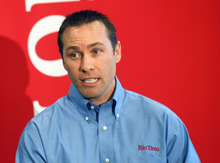This is an archived article that was published on sltrib.com in 2013, and information in the article may be outdated. It is provided only for personal research purposes and may not be reprinted.
Kennecott Utah Copper said Thursday its Bingham Canyon Mine experienced a large landslide, but no injuries were reported.
The slide occurred about 9:30 p.m. Wednesday along the pit mine's northeast wall, said Rio Tinto-Kennecott spokesman Kyle Bennett. The landslide, however, was anticipated and all employees had been evacuated ahead of time.
"We started noticing movement in that part of the mine in February," Bennett said, indicating at that time the mine's wall was slipping a fraction of an inch each day.
As the slipping continued and began to accelerate in the following weeks, Kennecott moved workers out of the area, utility lines were rerouted and the modular building that housed the mine monitoring equipment was relocated to safer ground. Kennecott also closed its visitors center for the rest of the year.
By early Wednesday, the northeast wall of the mine was slipping at a rate of 2 inches a day.
"At 11 a.m. yesterday we moved everyone out, including those who were working in the bottom of the mine," Bennett said, adding there were only 37 workers still laboring in the mine at that time. "All of our employees are safe and accounted for."
Bennett said the company has not yet determined the exact size of the slide. He said mining experts would be evaluating the slide area and its impact on future operations.
The Bingham Canyon operation, located in the Oquirrh Mountains in southwest Salt Lake County, is one of the world's largest open-pit mining operations. While ground movements in the Bingham Canyon mine are a frequent occurrence, large slides are not, Bennett said.
"Well, I guess we can now add landslides to the long list of hazards created by that mine," said Brian Moench, president of Utah Physicians for a Healthy Environment. "And I'm sure the dust [from the slide] will at least add another temporary pollution burden on our community."
Utah Physicians for a Healthy Environment was one of several environmental groups that filed suit against Kennecott in late 2011 for violating the Clean Air Act for nearly five years.
That lawsuit, still underway, noted that Kennecott is one of Utah's biggest sources of particle pollution, partly from dust kicked up as crews dig and haul ore.
But Bennett said the earth movement from the slide was contained to the mine and that minimal dust resulted from the slide.
Twitter: OberbeckBiz



